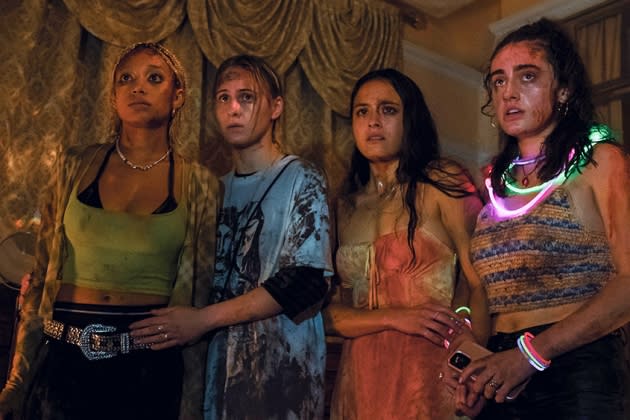How ‘Bodies Bodies Bodies’ Uses Neon and Phone Lighting to Fuel Its Hyper-Online Bloodlust
- Oops!Something went wrong.Please try again later.
- Oops!Something went wrong.Please try again later.
- Oops!Something went wrong.Please try again later.

Social media drives the performative interactions of entitled 20-somethings in Halina Reijn’s “Bodies Bodies Bodies,” but beneath their constructed personas, anxiety, fear and jealousy fester. These intense feelings were at the forefront of cinematographer Jasper Wolf’s mind, who wanted his extensive lighting choices to underscore each “new emotional boxing round.”
The A24 film stars Maria Bakalova as Bee, a young working-class woman who accompanies her new girlfriend Sophie (Amandla Stenberg) to a hurricane party thrown by Sophie’s uber-rich friends. After a murder-in-the-dark game goes wrong when someone turns up dead for real, the toxic group reignites old grudges and descends into cutthroat paranoia.
More from Variety
Elegance Bratton's 'The Inspection' Tapped for New York Film Festival Closing Night
'Medusa Deluxe' Review: One-Shot Hairdressing Murder Mystery Is an Elaborate, Backcombed Tease
Much of the action takes place at night after the power — and Wi-Fi — cuts out.
While staying grounded in plausibility, Wolf wanted alternative light sources to accentuate the “obvious” flashlights and camping lanterns. “We were mostly interested in maybe an emotional realism or illusionistic realism, that the color of the light could give you an extra thrill or an extra sense [of the characters],” he says. Party girl Alice (Rachel Sennott) drapes herself in glow stick jewelry, while type-A Jordan (Myha’la Harrold) goes for an LED headlamp. Chilled-out Greg (Lee Pace) even dons a vibrant blue light therapy mask.
Ever-present phone flashlights tap into the film’s hyper-online quality as the Gen Zers filter their barbs through social media buzzwords. The screens have maxed-out brightness that exposes their faces in the darkness. Wolf notes how this lighting style emulates a camera’s flash: “Maybe it’s also something that we know from online [when] you make selfies.”
The Chappaqua McMansion represented another opportunity to add color. Wolf worked with production designer April Lasky to install surreal emergency lights and to ensure each room had a distinct visual identity that could tie into the characters’ devolving emotional states. “The kitchen is a good example for the first time where there is this mistrust within the group,” Wolf says. “We play a lot in cyan colors, in blue green colors, where they start to turn against each other a little bit.” Later, a moment of explosive violence in an indoor basketball court riffs off an exit sign’s red.
“Bodies Bodies Bodies” marks Wolf’s second collaboration with Reijn after her first feature, “Instinct.” The Dutch duo prepared extensively by first choreographing on location with stand-ins, giving Reijn a foundation to then let things be looser and make space for improvisation when filming. Wolf operated the handheld camera and shot intuitively, letting the camera “behave sometimes as one of the characters in the group.”
Achieving this freedom within the film’s many long takes and the large ensemble’s movements called for a lighting approach with flexibility. “Part of the concept of having actors light each other — so for example, Jordan’s headlight or the flashlights — that gave us also anchors within a scene that we could play the lighting design off,” Wolf says.
Originally, the DP entertained the idea of shooting on film, but the production’s tight schedule necessitated a different approach. He first did test shots on film, then worked with colorist Damien van der Cruyssen to grade them and make a color profile that could be put into his camera of choice, the Arri Alexa Mini LF. “The reason the large format was instrumental for this film is just there’s so much darkness, and I knew that I wanted to be free in this darkness,” Wolf says. “I also liked the look of how the blacks behave and how the textures can survive. Even when I pushed it a lot, it still had this clean aesthetic within the rawness that we were after.”
As the group’s distrust intensifies, the lighting grows increasingly fractured. A pivotal moment in Bee and Sophie’s relationship takes place in a claustrophobic sauna, which Wolf stresses “is easily one of the smallest locations that I ever shot in.” He captured the scene with “two super minimum amount of lights,” including a small flashlight he balanced in his hands alongside the camera.
Adds Wolf, “We were playing with the idea that it became darker and darker in the movie. At one moment, the light’s almost gone.”
Best of Variety
From 'The Sandman' to 'Blonde': Books Made Into Movies and TV Series That You Should Read
Jennette McCurdy's Provocative Book 'I'm Glad My Mom Died' Is Already a No. 1 Bestseller
Sign up for Variety’s Newsletter. For the latest news, follow us on Facebook, Twitter, and Instagram.
